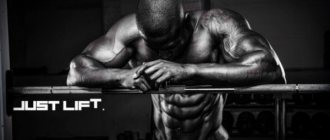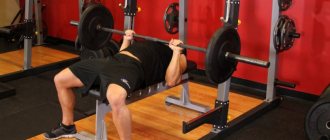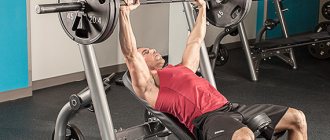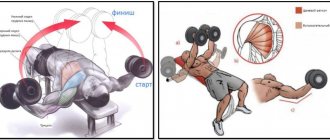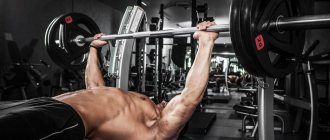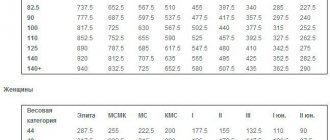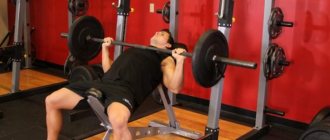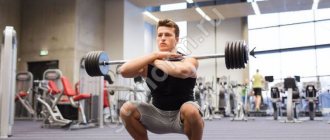| |
Author: Anton Yuzhakov
— MSMK in bench press and author of the site youiron.ru. Date: 2016-06-14
All articles by the author >
In the new series of articles we will talk about the bench press, first you need to look at the classic bench press and some techniques for taking the starting position. Afterwards, we will analyze the various bench press techniques and how they differ from each other. And in the third article we will finish with the nuances of the bench press.
Bench press
– a competitive exercise in two sports: Powerlifting and Bench Press. In weightlifting it is used as an auxiliary exercise for pushing, in bodybuilding it is one of the basic exercises for developing the pectoral muscles. It is also used in other sports to develop strength qualities or gain muscle mass in the upper limb and shoulder girdle.
This article will describe the competitive and training press in powerlifting to develop strength and improve the single lift of the movement. The technique presented is very different from the technique used in bodybuilding.
The bench press is a multi-joint exercise that involves working most of the body's muscles. From the shoulder girdle, the pectoralis major and minor muscles and the anterior bundle of the deltoid muscle are actively activated (dynamic contraction), and the arm muscles are also included - triceps, long head of the biceps (takes part in flexing the arm due to its attachment to the shoulder blade). Most of the remaining muscles work statically (static contraction) to maintain correct body position and maintain correct pressing technique.
Bench press bridge[edit | edit code]
Yuzhakov Anton Most in the bench press
Bridge in the bench press.
If it looks stupid but it works...it's not stupid.
Bridge
- This is a back arched position in the bench press exercise, which allows powerlifters to achieve several advantages:
- Firstly, the range of amplitude between the extreme points is reduced, and lifting the barbell a shorter distance makes lifting the weight much easier. Especially considering that the “dead point” is at the bottom of the amplitude.
- Secondly, the bridge allows you to use auxiliary muscles, primarily the latissimus dorsi.
- Thirdly, when lowering the barbell onto the chest, it becomes possible to absorb shock at the bottom point of the takeoff and at the very beginning of removing the barbell.
Technique[edit | edit code]
When performing a bridge press, special attention should be paid to the technique of its implementation. A powerlifter actually has two support points in this element: the shoulder blades and the feet.
In this exercise the legs
should serve as a strong support and basis for performing the movement. Feet should be wide apart for stability. The feet must be fully on the platform. In addition, they should be brought back, as close to the shoulders as possible. Tearing and moving them during the press is strictly prohibited by the rules. Therefore, immediately try to place them as convenient for you, within the rules. Shoes should be such that they do not slip, because the stability of your feet greatly affects the result; a significant part of the load is transferred to them (if you do everything correctly, of course).
shoulder blades
should be brought together as much as possible.
Basically, you have to stand or lean on your feet and shoulder blades. But the buttocks
should in no way become like that, since when performed correctly they simply touch the bench.
You should choose this elbow position
, in which the load will be evenly distributed between all muscle groups: pectoral, anterior deltoids and triceps. If the elbows are pressed to the body in the bench press, then the deltoids and triceps are maximally loaded; if the elbows are maximally apart, then the pectoral muscles are loaded. To lift maximum weight, the optimal position is in which the angle between the body and the humerus is about 45°.
Brushes
try not to bend, and to stiffen them and also to avoid injury, always wrap your wrists with elastic bandages.
The grip of the barbell
should be the maximum width allowed. those. 81 cm.
To take the starting position, you must first place your legs on the bench, and having arched the “bridge,” lower your legs from the bench to the floor and take a stable position, resting your feet. The main goal: to “pull” the shoulders as close to the pelvis as possible.
The movement of the bar both down and up should be uniform and slow. When the bar just barely touches your chest, you need to stop it without pressing it into your chest. And no repulses. This will already be a bench press, which is not a competitive exercise. Try to hold the barbell with the strength of your hands, as otherwise the barbell will not be torn off your chest if your hands are overloaded. Then sharply squeeze the barbell along the same trajectory as it was lowered onto the chest. This trajectory, as you should notice, is not entirely straight, but resembles an arc. When the barbell is torn from the chest, the movement should come from the legs by tensing them towards the head. And since this movement occurs parallel to the bench, this is how you maintain your contact with it. Try not to lift your pelvis off the bench.
Compliance with all the subtleties of the exercise technique allows you not only to achieve the desired effect, but also protects you from accidental injury.
Exercises for training the bridge[edit | edit code]
- it is recommended to include regular gymnastic or wrestling bridges in the warm-up program
- in the first stages of including this complex exercise in the training program, it is permissible to place a thick cushion under the lower back, closer to the thoracic region
- to develop arching in the bridge press, use the classic cobra yoga exercise
- Exercise "cobra"
- Gymnastic bridge
Bench press: execution technique
The bench press is a multi-joint free weight exercise that develops a comprehensive upper body workout. This exercise works almost all muscles, which is why it is one of the big three basic exercises, along with deadlifts and squats with a barbell.
Performing bench press in bodybuilding
In this article we will look at the classic bench press, but in a bodybuilding environment, i.e. with an emphasis on the pectoral muscles. The load in this exercise is placed on the pectoralis major muscles, triceps, and anterior deltoid muscles. Among the stabilizer muscles, the trapezius, latissimus, abdominal and leg muscles are involved in the work. Wow! The effect of wild anabolism is an increase in strength and muscle mass in the upper part of your body.
The bench press is a very popular exercise in modern gyms. And the most popular question among trainees is “How much do you bench?” Everyone puffs at this exercise in an attempt to squeeze out more and everyone, oddly enough, has their own technique. Many people think that the bench press is as simple as three pennies. Once you have learned a bad technique, it will be very difficult to get rid of mistakes and move on to high-quality performance. Let's master the theory, we'll be smarter.
The bench press is performed on a horizontal bench while lying on your back. In the starting position, the projectile is placed on outstretched arms above the chest. The barbell is lowered onto the chest (until it touches lightly) and then the barbell is squeezed to its original position.
Before performing the bench press, be sure to do a general warm-up. Do one set with an empty bar to get your body to remember the mechanics and a few warm-up sets with light weights. The goal of warm-up sets is not to tire you, but to warm up the target muscles involved in the exercise. Remember, a good warm-up is your protection from injury.
Do the bench press either in a power rack with restraints or on a bench press bench with racks. Select a comfortable height for the supports on which the bar will rest.
1- Power frame for bench press; 2- Bench rack for bench press
Do bench presses in a T-shirt, showing off your bare torso on the beach. Position yourself on the bench so that the barbell and plates do not touch the stops when you squeeze it out. When working with heavy weights, ask your partner to help you remove the bar from the racks and put it back. Believe me, a lot of effort is spent on this.
Your position on the bench should be secure and stable. This is achieved by four points of support - the back of the head, shoulder blades, pelvis, feet. Fix your head and don’t try to move it while doing the exercise. Eyes at the level of the neck. Look straight up, do not try to accompany the bar during movement.
Support points during bench press
Before performing the exercise, squeeze your shoulder blades together and lower your shoulders back, chest forward. This will create tension in the trapezius and lats. Arch your lower back, but don’t be a “Bridge.” Leave the bridge to the security forces - Your task is to purposefully load the upper body and avoid injuries. The deflection should be moderate. The pelvis touches the bench, the buttocks are very tense.
The legs are spread wide apart, the angle formed by the thigh and lower leg should not be more than 90°. The foot rests on the floor with its entire surface and is pressed forcefully into the floor. Legs are fully tense. The grip on the barbell varies from person to person, but should be wider than shoulder width. The wider the grip, the more danger it poses to the shoulder joints. The key criterion for choosing grip width is parallel forearms at the lowest point of the amplitude.
Forearms parallel to each other at the lowest point
Wrap your hands tightly around the bar with a closed grip - and you should try to squeeze the bar with your hands and, as it were, pull it towards your shoulder blades. This will create a confident position in holding the barbell. Keep the bar as close to the top of your palm as possible, not to your fingers. The elbows should be located under the hands, and not forward.
Read more: Is it worth saving a relationship? In what cases? The whole truth
Position of the bar in the palm
After removing the bar from the racks (your partner should help you do this), pause. Fix the projectile above the middle of your chest. The bar should not swing. At this moment, bring your shoulder blades together and, while inhaling, begin to slowly and under control lower the projectile to the bottom of your pectoral muscles, which corresponds to the line below your nipples.
The bar is lowered to the bottom of the chest
Your forearms should be parallel to each other at the bottom of the movement. The lowest point is the barbell lightly touching your chest. You should not put the barbell on your chest or do a chop. Hold the projectile with the strength of your hands. If you lower the barbell, it will be more difficult to lift it up later.
Because The version of the press we are considering places an emphasis on the pectoral muscles; you should spread your elbows to the sides, and not press them against the body. But do not try to spread your elbows so much that the barbell falls on your neck, otherwise your shoulder joints will be injured very quickly.
Your task is to find the golden mean when your elbows are under your hands, spread to the sides and do not fall below the bench. An outside perspective can help identify all these subtle but very important points.
Optimal placement of elbows at the lowest point
Push the barbell up with a powerful force as you exhale. The trajectory of the bar when lifting is almost vertical or slightly curved towards the head. The main thing is that in your movement there is no tendency to squeeze the bar towards your legs.
Fix the bar at the top point, taking a short pause. At the same time, you should not straighten your elbows completely, otherwise the load from the pecs will go to the triceps. After making sure that the bar is motionless, bring your shoulder blades together again and lower the apparatus to the bottom point of your pecs.
https://youtu.be/qQnTFAO3jVE
Bodybuilding style
Bodybuilding has a different goal, although at first glance it may seem that the bench presses are no different. In bodybuilding, the main goal is to load the target muscle so that it hypertrophies; increasing strength is a consequence, not the main goal. Of course, an increase in strength indicators is also a desirable process.
In bodybuilding, the bench press is associated with the development of the pectorals, although there are much better exercises, but today we are not talking about them. The bench press still involves the muscles of the chest, shoulders and triceps, but the emphasis of the load shifts towards the chest. This can be achieved in the following way.
Firstly , the elbows should be spread out to the sides, and not pressed against the body, this reduces the degree of participation of the triceps during the exercise. The bar of the bar should be lowered to the line of the nipples or a little higher, but in no case to the upper chest or collarbone! This will lead to overstretching of the joint capsules of the shoulders and chest muscles, which will lead to injury.
Secondly , you should not rest your feet on the floor and touch the bench with your buttocks. As a rule, in bodybuilding they minimize the participation of the legs in the press, and lie completely with the buttocks on the bench. In this case, the lower back should either be pressed tightly against the bench or maintain a natural deflection. When using this technique, a common mistake occurs - if there is too much weight on the bar, the athlete begins to help himself with his hands and stands on the bridge. The problem is that such a bridge is technically incorrect and leads to injury.
People with lower back problems should never resort to such things. To prevent this, you can completely eliminate your legs from work by raising them and pulling them towards your body. The weight of the weight with this technique will drop significantly.
Thirdly , the weight of the weights must be adequate. Bodybuilding style does not use weights higher than 80% of 1RM, otherwise it can lead to injury. Usually you take weights that you can do in 8-10 repetitions in 4-5 approaches.
As a rule, bodybuilding also uses some technical tricks in the bench press, with which you can further load the pectoral muscles. This concerns the range of motion.
At the top point of the movement, it is recommended not to fully extend your arms until the elbow joint locks; this will allow you to constantly keep your pecs under load. The same can be done with the lower part of the amplitude. If you do not lower the barbell to your chest and do not straighten your elbows at the top of the movement, then this will be called working within the amplitude. Combined with a high number of repetitions, this will allow you to achieve a powerful pump.
Opinion of Dmitry Smirnov
At this point we say goodbye to Tim Henricks and present the opinion of former Men's Health fitness editor Dmitry Smirnov. He believes that there is nothing wrong with bending on the bench press: “Excessive bending in the lumbar region, especially under load, is really very dangerous. Only here the bridge is made by deflection in the lower part of the thoracic region, for which deflections (as well as mobility in general) are only beneficial. This is the only part of the spine that needs mobility, not stability. In principle, it is impossible to bend in the lumbar region; there is a margin of flexibility of only 14 degrees, if my memory serves me correctly.”
However, we are talking here about normal, not excessive deflection.
Why do they bend on the bench press?
Excessive arching of the back emerged as a way to manipulate powerlifting rules, which state that the upper back and buttocks must always touch the bench. The rules are not clear about the lower back, and that makes sense. Given the natural curvature of the spine and the fact that people have buttocks - (and powerlifters, of course, they have larger ones than ordinary people) - there is no way for an athlete's lower back to touch the bench.
The use of deflection, regardless of its magnitude, has never been prohibited. And since with a large deflection, the distance by which you need to lift the barbell decreases slightly and, accordingly, squeezing the weight becomes a little easier, this technique began to be actively used in competitions and training. It is clear that this technique quickly spread to the masses.
If you are at a powerlifting competition and your goal is to push the maximum weight, then there is no option - bend over . But I still believe that you don’t need to train with a lot of backbending often.
And if you're not a competitive powerlifter, but an average gym goer who just wants to be stronger and bigger, then stop trying to make a St. Louis arch with your spine.
Amateurs quickly “grabbed it” - the larger the bridge, the more it looks like a professional powerlifter. True, it doesn’t always work out.
How to prepare your body for stress
Since the exercise in question is related to powerlifting, it is quite difficult to perform. And if an athlete does not feel able to bridge the bench press, perhaps he should practice.
First of all, learn how to do an ordinary gymnastic bridge, as well as a bridge with weights. And only when your back muscles are ready for serious loads can you combine this exercise with a bench press.
The depth of the bridge may not be the same - it depends on the specific training of each athlete. However, in any case, it is important that the body is securely fixed and that you do not experience discomfort. After a few trials and errors, you will definitely be able to understand for yourself whether you need to do the bench press with or without a bridge.
Otherwise, the risk of injury increases. So if you want to experiment with a new exercise, be as careful as possible. Learn the bench press bridge technique and follow simple rules, then you can improve your physical performance.
With a strong deflection on the bench press, muscles grow worse
By doing a bridge on the bench press, we shorten the range of motion, so the exercise becomes easier and we can press more weight. Disadvantage: a muscle that does not have a full range of motion does not receive enough load and thus its growth potential is reduced. The more a muscle is stretched during an exercise, the better it grows.
Just as the negative incline bench press does not develop the pectoral muscles and deltoids as well, the bench press with a very high bridge has a negative impact on the growth of the pectoral muscles.
Too much bench press = risk of injury
Firstly, with a large deflection, a lot of pressure is created on the lower back. When the spine is severely arched, the intervertebral discs and nerves are at great risk of injury. Ask someone with a bad back to do a big back arch while doing a bench press, and the back pain will immediately make itself known.
Even taking into account the fact that the spine during such a deflection does not experience such a colossal load as during squats, but still, during heavy bench presses a lot of weight is used, and if the legs are also raised at the same time, the combination of these factors can lead to injury. (In addition, do not forget what cumulative trauma is – Zozhnik’s note).
Second, powerlifters are primarily concerned with their bench press, and most powerlifters regularly perform squats and deadlifts, which places significant stress on the spine. And since the muscles in the lower back do not recover as quickly, the bench press day in the program, which is intended as a “rest day” for the back and lower body, turns out to be another day of stress.
A strong arch in the back will also reduce stability in the legs. To bend your back well, your feet need to be behind your hips, but the further they go, the harder it is to maintain a stable position in your legs without lifting your buttocks from the bench.
